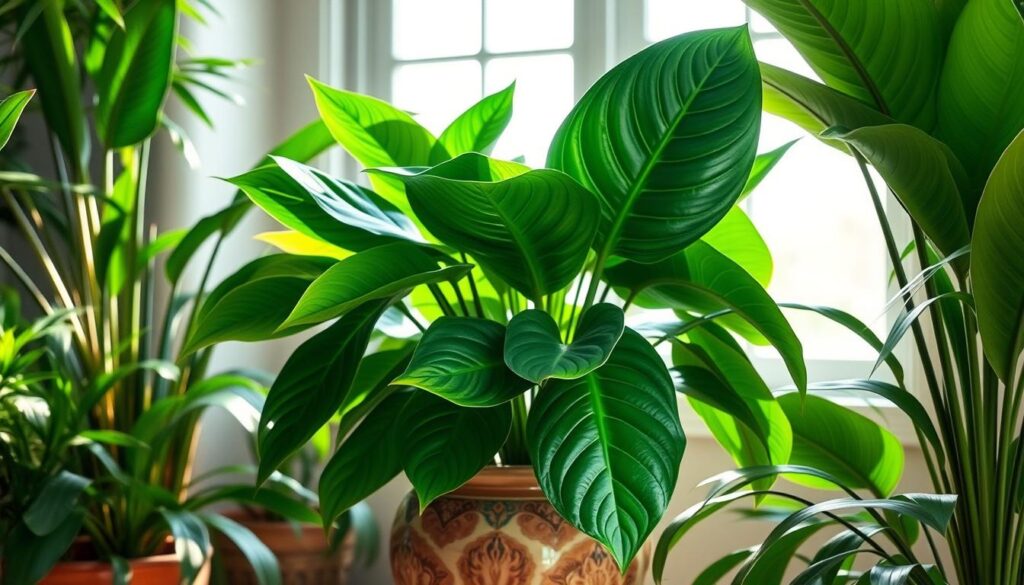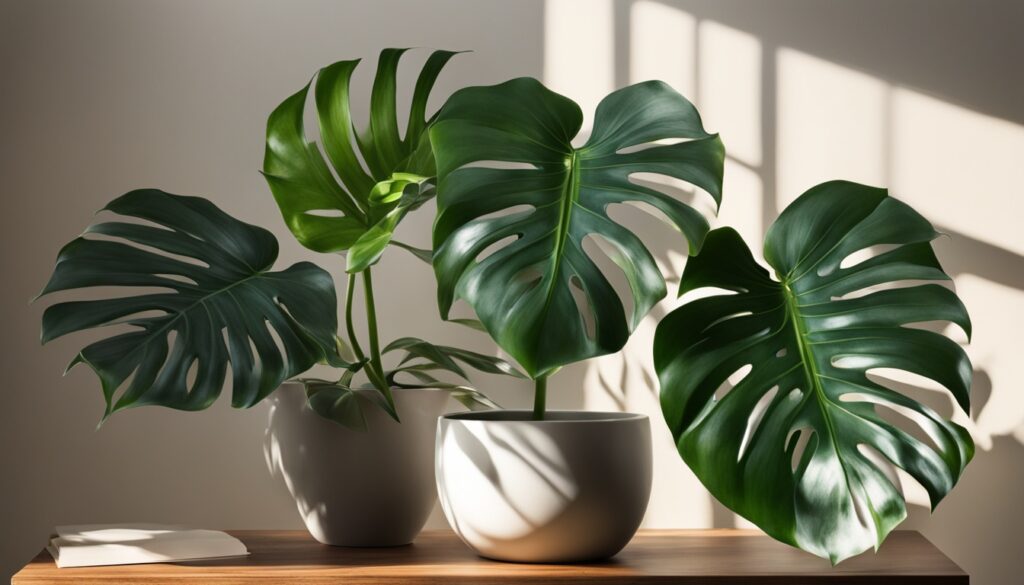Ever wondered why the Emerald Philodendron is so loved by indoor plant fans? Its shiny, heart-shaped leaves make it a beauty to see. Plus, it’s great for cleaning the air in your home or office. Learn how to keep this lush plant and turn your space into a green paradise.
Key Takeaways
- The Emerald Philodendron is a member of the Araceae family, known for its vibrant green foliage.
- This low-maintenance plant thrives in medium to bright indirect light, making it an excellent choice for indoor spaces.
- The Emerald Philodendron can grow leaves up to 2 feet long, adding a tropical touch to any room.
- With proper care, this fast-growing plant can be supported by a moss pole or trellis, enhancing its lush appearance.
- The Emerald Philodendron is an air-purifying plant, helping to improve indoor air quality.
Understanding the Emerald Philodendron
The Emerald Philodendron, also known as the Philodendron erubescens, is a stunning aroid plant from Central and South America’s tropical rainforests. It has large, glossy, emerald-green leaves that can grow over 2 feet long. This makes it a beautiful addition to any indoor space.
Origin and Natural Habitat
The Emerald Philodendron comes from the lush rainforests of Costa Rica, Colombia, and other parts of Central and South America. In its natural home, this aroid plant climbs up trees with its aerial roots. It can grow up to 60 feet tall.
Botanical Classification
The Emerald Philodendron is part of the Araceae family. This family includes many tropical houseplants known for their unique leaves. It is classified as Philodendron erubescens, a species loved for its vibrant, heart-shaped leaves.
Physical Characteristics
The Emerald Philodendron has large, glossy, emerald-green leaves that grow upright. The leaves’ undersides often show a striking purple-red color. As the heart-leaf philodendron grows, its leaves can change color, from bright green to deep, rich shades.
“The Emerald Philodendron is a true showstopper, with its lush, vibrant foliage that can transform any indoor space into a tropical oasis.”
Essential Growing Requirements
The Emerald Philodendron is a low-maintenance houseplant. It has a lush, tropical look and grows well in many indoor spots. This makes it perfect for both new and seasoned plant lovers.
To help the Emerald Philodendron grow its best, it needs the right growing conditions. Let’s look at what it needs to thrive:
- Light: It likes bright, indirect light but can handle less light too. This makes it great for different indoor places.
- Temperature: It does well in temperatures between 65-80°F (18-27°C). This shows it can handle a variety of indoor temperatures.
- Humidity: High humidity helps keep its leaves shiny and green.
- Watering: Water it when the top inch of soil feels dry. Avoid too much water to prevent root rot. It can handle missing a watering now and then.
- Soil: Use a potting mix that drains well and is rich in organic matter. This helps its roots grow strong.
| Requirement | Optimal Conditions |
|---|---|
| Light | Bright, indirect light |
| Temperature | 65-80°F (18-27°C) |
| Humidity | High (60-80%) |
| Watering | Water when top inch of soil is dry |
| Soil | Well-draining, rich in organic matter |
By meeting these needs, you can enjoy the Emerald Philodendron’s beautiful foliage. It’s a great choice for adding greenery to your home.
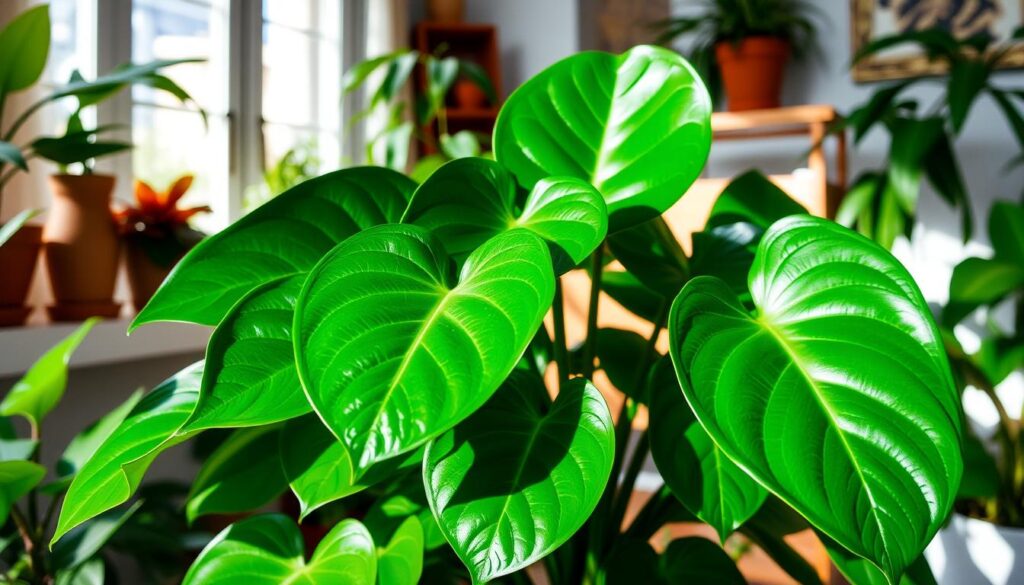
“The Emerald Philodendron is a true testament to the beauty and resilience of tropical plants, thriving in a variety of indoor conditions with minimal effort.”
Light and Temperature Preferences
The Emerald Philodendron is a favorite tropical houseplant. It loves bright, indirect light. But, direct sunlight can burn its leaves. The best temperature for it is between 65-80°F (18-27°C).
Optimal Light Conditions
For your Emerald Philodendron to stay healthy, put it in a bright, indirect light spot. Direct sunlight can make the leaves fade and get damaged. If your home lacks natural light, a grow light can help.
Temperature Range for Growth
The Emerald Philodendron grows best in warm, steady temperatures. Keep it between 65-80°F (18-27°C). Avoid sudden temperature changes or cold drafts to prevent damage.
Protecting from Drafts
Keep your Emerald Philodendron away from cold drafts. This includes air conditioning vents and open windows, especially in winter. Cold air can make the leaves turn yellow, wilt, or fall off. A warm, stable environment is best for your plant.
| Light Requirement | Temperature Range | Humidity Preference |
|---|---|---|
| Bright, indirect light | 65-80°F (18-27°C) | 60-80% |
Watering and Humidity Needs
Proper watering and maintaining optimal humidity levels are key for the emerald philodendron, a lush tropical houseplant. This plant does best when the top inch of soil is dry before watering. Watering should be every 9 days for a 5-inch pot in indirect sunlight.
To prevent root rot, avoid overwatering the emerald philodendron. In winter, water less but keep the soil moist. This helps the plant during its dormant period.
The emerald philodendron also loves high humidity, best between 60-80%. To boost humidity, mist the leaves often or place the plant near a water tray. This helps it thrive, just like in the rainforests of Central and South America.
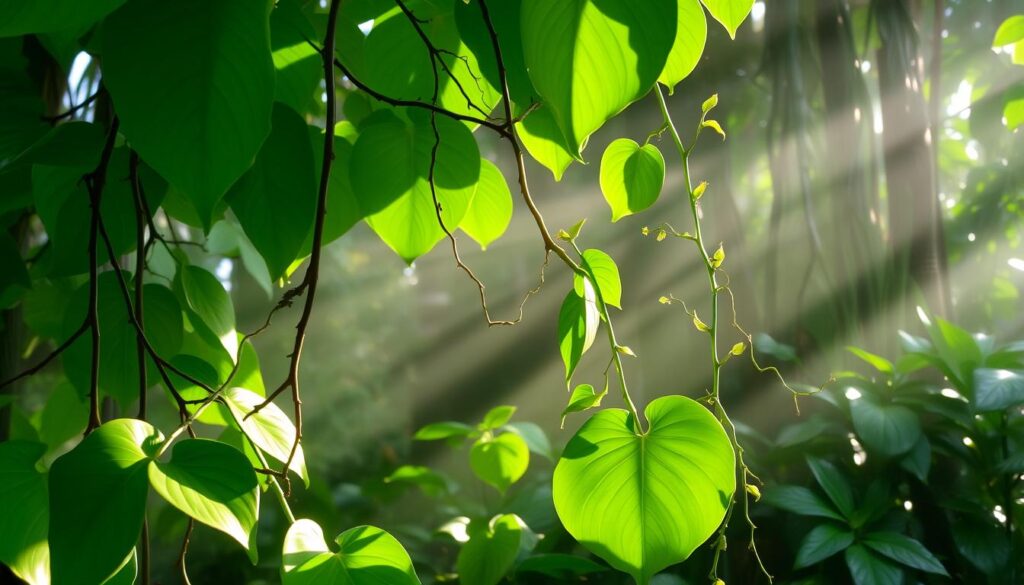
By following these watering and humidity tips, your emerald philodendron will stay healthy and vibrant. It will add a touch of tropical beauty to your home.
Soil and Potting Requirements
The Emerald Philodendron, or philodendron erubescens, loves a potting mix that drains well. This mix should be like its natural home. It should have potting soil, peat moss, and perlite.
This mix helps the plant grow well. It keeps the soil moist but not too wet. It also lets air in and holds nutrients for the plant’s green leaves and growth.
Ideal Soil Composition
A good mix for the Emerald Philodendron is one part peat moss, one part perlite, and one part orchid or pine bark. This mix keeps the soil right for the plant. It holds moisture, lets air in, and gives nutrients.
Adding sphagnum moss and vermiculite can make the soil even better. They help the soil hold water and nutrients.
Drainage Considerations
Drainage is key for the Emerald Philodendron. It can get root rot if the soil is too wet. Make sure the pot has holes for water to drain.
Using terracotta pots is a good idea. They help pull out extra water. Don’t use old soil, as it can hold too much water. Add perlite or coarse sand to keep the soil dry.
Repotting Guidelines
Repot the Emerald Philodendron every 2 to 3 years. Or when it’s too big for its pot. Spring is the best time to do this, when the plant is growing fast.
When you repot, choose a pot that’s 1-2 inches bigger. This gives the plant room to grow.
| Soil Composition | Drainage | Repotting |
|---|---|---|
| – 1 part peat moss – 1 part perlite – 1 part orchid bark/pine bark – Sphagnum moss – Vermiculite |
– Terracotta pots – Avoid reusing old soil – Add perlite or coarse sand |
– Every 2-3 years – Coincide with spring growth – Choose a pot 1-2 inches larger |
“Proper soil composition and potting techniques are crucial for maintaining the plant’s health and ensuring optimal growth.”
Fertilizing Schedule and Methods
Proper fertilization is key for the emerald plant, a favorite tropical houseplant. Feed your Philodendron with a balanced liquid fertilizer every 4 to 6 weeks in spring and summer.
To avoid over-fertilizing, cut the fertilizer in half. This gives your plant the nutrients it needs without harming its roots. In winter, when growth is slower, you can stop fertilizing. Start again in spring when new growth appears.
Here’s a simple feeding schedule:
- Fertilize every 4-6 weeks in spring and summer.
- Reduce or skip fertilizing in fall and winter.
- Use a balanced liquid fertilizer with a 10-10-10 ratio.
- Dilute the fertilizer to half-strength to prevent over-fertilizing.
Good fertilization helps your emerald plant grow lush and healthy. By following these tips, your tropical houseplant will thrive and beautify your home.
| Fertilizer Frequency | Growth Rate | Toxicity | Pruning Time | Propagation Methods |
|---|---|---|---|---|
| Every 4-6 weeks during growing season, 8-10 weeks in fall and winter | Up to 1-2 feet per year | Toxic to pets (contains calcium oxalate crystals) | Early spring | Stem cuttings in water or soil |
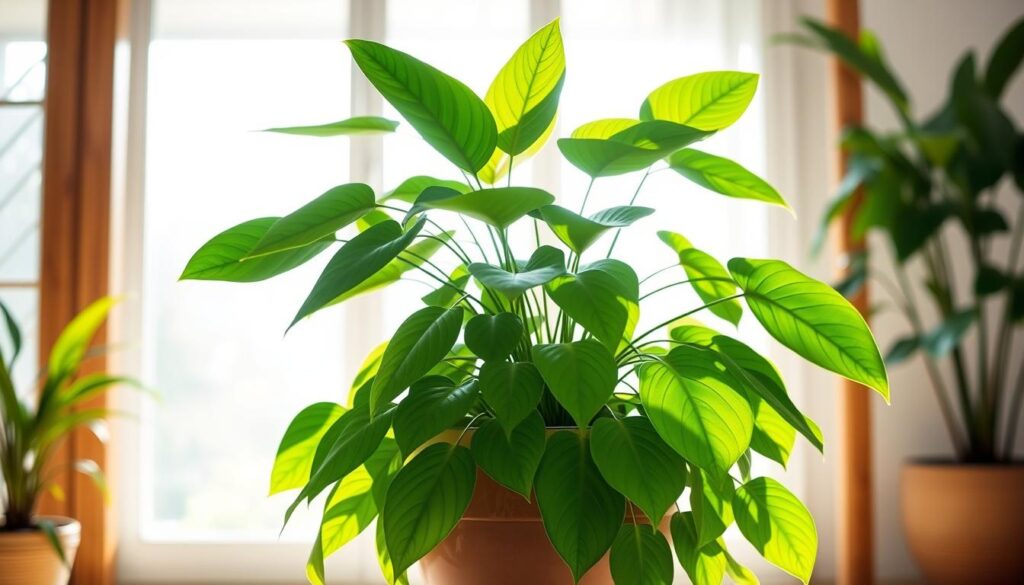
“Proper fertilization is the key to maintaining the vibrant, tropical appearance of the Philodendron Golden Dragon.”
Training and Support Systems
The Emerald Philodendron loves to climb, just like it does in the wild. It needs support like moss poles or trellises to grow well. By attaching it to a moss pole, you help it grow upwards and keep its shape.
To make it bushier, pinch back the tips. Regular pruning keeps it looking good and growing strong.
Moss Pole Usage
Moss poles are great for supporting plants like the Emerald Philodendron. They help the plant grow upwards naturally. Here’s how to use one:
- Use plant ties or clips to attach the stem to the moss pole.
- Check and adjust the ties as the plant grows.
- Get a bigger moss pole as the plant gets taller.
Climbing Techniques
The Emerald Philodendron can also climb on trellises or walls. This makes it look amazing and helps it grow more.
To train it, gently guide the stems to the support. Use clips or ties to keep it in place. Prune it regularly to keep its shape.
| Climbing Support | Benefits |
|---|---|
| Moss Pole | Mimics natural growth habit, provides stability, encourages upward growth |
| Trellis | Offers versatility in shape and design, allows for more horizontal growth |
| Nearby Structures | Utilizes existing features, creates unique and natural-looking displays |
With the right training and support, your Emerald Philodendron will thrive. It will become a beautiful centerpiece in your home.
“Philodendrons are known for their natural climbing abilities, and providing the right support can help them reach their full growth potential.”
Propagation Techniques
The philodendron erubescens, also known as the lemon lime philodendron, is a favorite houseplant. It’s known for its bright leaves and long vines. Growing new plants from stem cuttings is easy.
To start, pick a healthy stem with leaves and a node. Use clean pruners to cut a six-inch piece just below a node. Roots will show in about a week or up to three to four weeks, depending on the plant and its environment.
- Put the stem cutting in a clean container with water or potting soil.
- Keep it humid and warm, around 70-80°F, to help roots grow.
- When roots are one inch long, move the cutting to a pot with fresh soil.
- Keep the soil moist but not too wet. Give it bright, indirect light.
Spring or early summer is the best time to propagate philodendrons. Use cuttings from a mature plant for better results. Remember, the leaf nodes are key for new growth.
| Propagation Technique | Rooting Time | Recommended Season |
|---|---|---|
| Stem Cuttings in Water | 1-4 weeks | Spring, Summer, Fall |
| Stem Cuttings in Soil | 2-4 weeks | Spring, Summer, Fall |
Looking to grow more philodendrons or share them? Propagation is a fun and rewarding way to do so.
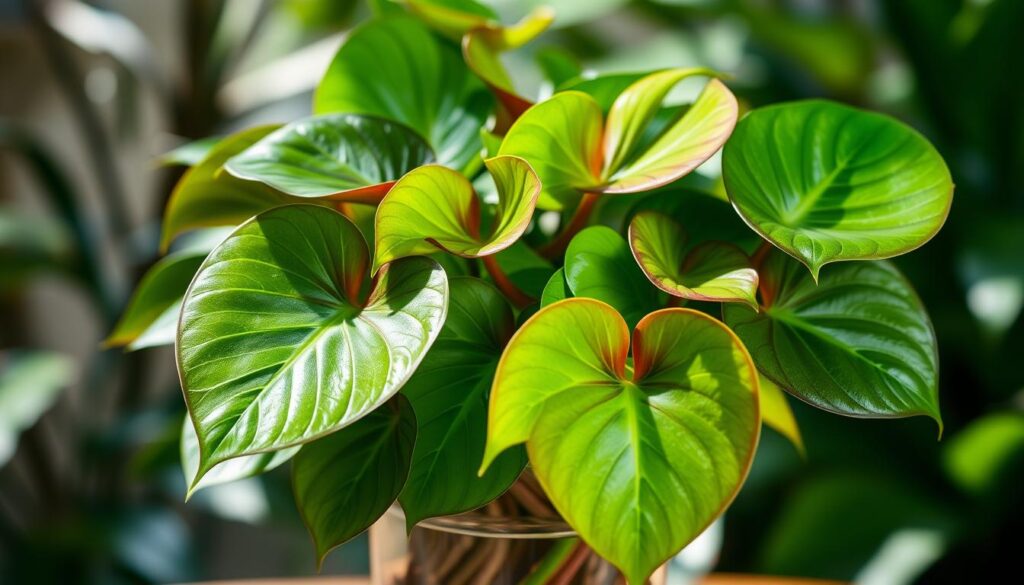
“Propagating philodendrons is a great way to fill your home with lush, tropical greenery.”
Common Growth Issues and Solutions
The emerald philodendron can do well indoors with proper care. But, it might face some common growth problems. Knowing and fixing these issues helps keep your tropical houseplant looking great.
Pest Management
The emerald philodendron can get pests like spider mites, aphids, and mealybugs. It’s important to check the plant often and catch pests early. If you see pests, use neem oil or insecticidal soap to get rid of them.
Disease Prevention
Fungal diseases can hit the emerald philodendron, showing as spots on leaves or a musty smell. Keeping the soil right and air moving helps prevent these diseases. Don’t water too much, as it can cause root rot and other problems.
Troubleshooting Tips
- Yellow leaves mean too much water or root rot, while droopy leaves show it’s not getting enough water.
- Browned leaf tips are from too much sun, and not enough light can cause discoloration and slow growth.
- Leaf curling and browning happen when the plant gets too cold or has sudden temperature changes.
By tackling these common problems early, your emerald philodendron can stay healthy and look its best. Regular checks, adjusting care, and preventive steps help keep your tropical houseplant looking good.
Seasonal Care Guidelines
The emerald philodendron is an easy-care houseplant that needs some seasonal care. In the spring and summer, it grows fast. So, you should water and fertilize it more often.
Give it bright, indirect light and keep the air humid. This helps it feel like it’s in its natural tropical home. When the days get shorter in fall and winter, change its light and water it less. This helps it grow slower.
- In spring and summer, water the philodendron 1-2 times per week and apply a balanced liquid fertilizer every 2-4 weeks.
- In fall and winter, decrease watering to once a week and avoid fertilizing to allow the plant to rest.
- Regularly clean the leaves with a damp cloth to remove dust and maintain the plant’s healthy appearance year-round.
- Protect the philodendron from cold drafts and sudden temperature fluctuations, as it prefers consistent warm temperatures between 21-29°C (70-84°F).
By changing how you care for it with the seasons, your emerald plant will do great. It will be a beautiful easy-care houseplant in your home or office.
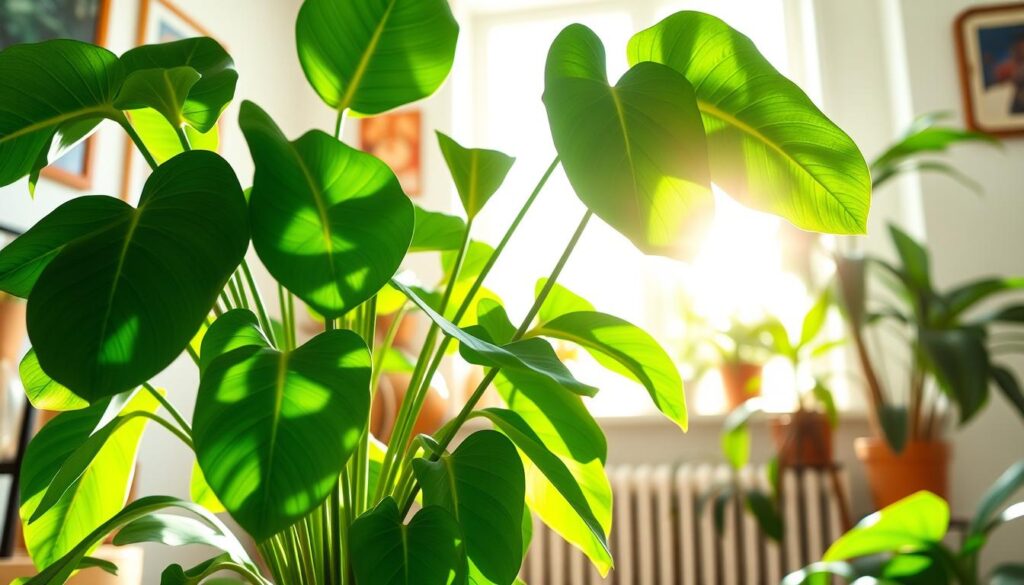
Air Purification Benefits
The tropical emerald philodendron is known for its amazing air-purifying skills. This tough tropical houseplant can take out many indoor air pollutants. This makes your living space healthier.
A NASA study found that indoor plants like the emerald philodendron can cut air pollution by up to 87%. Its big, shiny leaves are key to its air-cleaning power. They help remove harmful stuff like formaldehyde, xylene, and toluene.
The emerald philodendron also makes the air more humid. This can lower infection risks by 30-50%, says the Agricultural University of Norway. Plus, having plants at work can boost productivity by 15%, a University of Exeter study found.
Having the emerald philodendron around can make you feel less tired and less headache-prone, a Journal of Environmental Psychology study says. It also makes you feel less stressed, with up to a 30% drop in stress levels, the University of Technology, Sydney reports.
Adding the emerald philodendron to your home or office brings many air-purifying perks. It helps make your indoor space healthier and more productive.
Decorative Uses and Styling Tips
The Emerald Philodendron has lush, vibrant leaves. It’s perfect for adding beauty to any room. You can hang it to make your space look like a jungle.
Interior Design Applications
Where you put the emerald plant really matters. In living rooms or offices, it becomes a beautiful centerpiece. It makes the room feel deeper and more interesting.
For a calmer look, put it in a corner or on a side table. This lets its leaves flow beautifully.
Plant Placement Strategies
- Hang the emerald plant in a basket to create a lush, cascading effect.
- Place the trailing philodendron on high shelves or ledges to showcase its natural trailing habit.
- Situate the Emerald Philodendron in bathrooms to take advantage of the naturally humid environment.
- Pair the emerald plant with other tropical foliage plants for a cohesive, jungle-inspired look.
- Utilize decorative stakes or moss poles to support the trailing philodendron and encourage vertical growth, adding height and visual interest to your interior design.
By carefully placing and styling the Emerald Philodendron, you can make any room look amazing. It adds a lush, captivating touch.
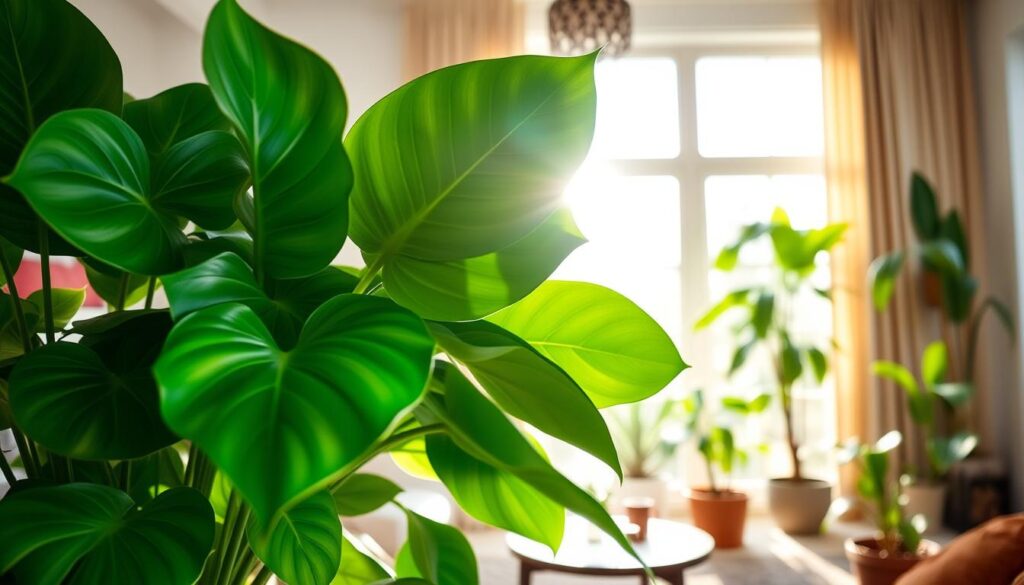
“The Emerald Philodendron is a true statement plant, adding a touch of tropical elegance to any indoor space.”
Purchasing Guide and Price Range
The Emerald Philodendron, also known as the Philodendron erubescens, is a popular tropical houseplant. It’s widely available in plant nurseries and online stores. Prices range from $20 to $50, depending on the size and maturity of the plant.
When buying an Emerald Philodendron, look for plants with vibrant, undamaged leaves. Check for any signs of pests or diseases. Buying from reputable sellers, whether in-person or online, ensures the plant’s health and authenticity.
For larger Emerald Philodendrons, prices can go over $100. These mature plants have a more impressive size and fuller foliage. They make great statement pieces for indoor spaces. When buying online, consider the shipping conditions to ensure the plant arrives well.
| Plant Size | Price Range |
|---|---|
| Small (4-6 inches) | $20 – $30 |
| Medium (8-12 inches) | $30 – $50 |
| Large (16-24 inches) | $50 – $100+ |
The price of an Emerald Philodendron can vary based on several factors. These include the seller’s reputation, the plant’s health, and any unique features or variegation. By considering these factors and shopping from reputable sources, you can find the perfect Emerald Philodendron to enhance your indoor living space.
“The Emerald Philodendron is a stunning addition to any home, with its lush, tropical foliage and easy-care nature. Whether you’re a seasoned plant enthusiast or a beginner, this versatile houseplant is sure to bring a touch of verdant beauty to your space.”
Conclusion
The Emerald Philodendron is a beautiful tropical houseplant. It’s easy to care for and adds beauty to any room. Its lush leaves and ability to clean the air make it a favorite among plant lovers.
By following the care tips in this article, you can enjoy the Emerald Philodendron’s beauty for years. It’s perfect for both new and experienced plant owners. It brings a tropical vibe to any space.
The Emerald Philodendron is great for any indoor plant collection. It looks good in many lighting conditions. Let it bring greenery and clean air to your home or office.
